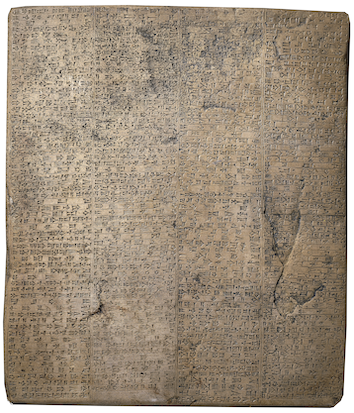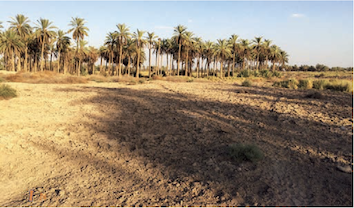Esiskur (New Year's temple of Marduk outside Babylon)
Marduk's New Year's temple (Akkadian bīt akīti) was located outside of the inner city, north of the Ištar Gate, at the end of the Processional Way. Despite the importance of the akītu-festival at Babylon, during which the king takes the hand of Marduk to confirm or renew his position as the king of Babylon, Esiskur is only first mentioned by name in Akkadian inscriptions of the Neo-Babylonian ruler Nebuchadnezzar II (r. 604–562 BC), one of its only two certainly-known builders. Because it was not inside Babylon itself, Esiskur was not mentioned among the forty-three temples named in Tablet IV of the scholarly compendium Tintir = Babylon. Babylon's New Year's temple survived until at least 80 BC.

BM 129397, a large stone tablet that bears a long Akkadian inscription that is now commonly referred to as the "East India House Inscription." The description of Nebuchadnezzar's rebuilding of Esiskur is recorded in lines iv 7–13. Image adapted from the British Museum Collection website. Credit: Trustees of the British Museum.
Names and Spellings
This temple at Babylon went by the Sumerian ceremonial name Esiskur, which means "House of the Sacrifice."
- Written Forms: e₂-siskur₂.
Known Builders
- Neo-Assyrian (ca. 911–612 BC)
- Ashurbanipal (r. 668–ca. 631 BC)
- Neo-Babylonian (ca. 625–539 BC)
- Nebuchadnezzar II (r. 604–562 BC)
Building History
Around 639–638 BC, the Assyrian king Ashurbanipal renovated Marduk's New Year's temple, a building that he referred to as "akītu-house of divine supremacy" (Akkadia akīt enlilūti). Unfortunately, none of the details about the work are known since the Akkadian inscription describing this accomplishment of Assyria's last great king is very badly damaged.
Several Akkadian inscriptions of the Neo-Babylonian ruler Nebuchadnezzar II, including one written on a large stone tablet (the so-called "East India House Inscription"), record that this ruler rebuilt Esiskur. The relevant passage of that text reads.
Contrary to Nebuchadnezzar's claim to have constructed Esiskur with baked brick (Akkadian agurru), an Astronomical Dairy entry for the Year 133 BC states that the temple was then built from unbaked brick (Akkadian libittu).
In connection with work on Babylon's New Year's temple, Nebuchadnezzar rebuilt and lavishly decorated Marduk's ceremonial boat Maumuša (Sumerian for "Boat of Command"), which Babylon's patron used to reach Esiskur after departing the inner city.
Nabonidus, Babylon's last native king, in an Akkadian inscription written on badly-damaged basalt stele claims to have made generous donations to Babylon's temples and their divine residents. For Esiskur, and the gods Marduk, Nabû and Nergal, he records that he provided gifts. The relevant section of that text reads:

Photograph of Babylon's "Eastern Tell," a proposed location of Babylon's New Year's temple Esiskur. Photo credit: Olof Pedersén (October 2015). Image from O. Pedersén, Babylon: The Great City p. 266 fig. 7.13.
Archaeological Remains
Esiskur has not yet been positively identified in the archaeological record. It has been tentatively proposed at the New Year's temple might have been located in the area of the Large Parthian building excavated by German archaeologists under the direction of Jürgen Schmidt (1967–72), in the area now-referred to as the "Eastern Tell." This building was ca. 230 m north of the unexcavated stretch of the Processional Way. Due to high groundwater, building levels earlier than the Parthian Period could not be explored and, thus, it is not possible to confirm whether or not Esiskur might have been located under the ruins of this Parthian building.
Further Reading
- George, A.R. 1993. House Most High. The Temples of Ancient Mesopotamia (Mesopotamian Civilizations 5), Winona Lake, p. 142 no. 993.
- Pedersén, O. 2021. Babylon: The Great City, Münster, pp. 200 and 267–268.
Jamie Novotny
Jamie Novotny, 'Esiskur (New Year's temple of Marduk outside Babylon)', Babylonian Temples and Monumental Architecture online (BTMAo), The BTMAo Project, a sub-project of MOCCI, [http://oracc.org/btmao/Babylon/TemplesandZiggurat/Esiskur/]